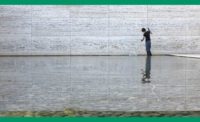The world is urbanizing at a breathtaking pace, and cities have become a battleground for wealth and privilege. Those who have them feel entitled to dictate the form and function of urban areas; those who don’t just want to retain their homes.
Housing insecurity—be it a result of forced migration or rent increases—and what it means for our cities (and identities) is a defining issue of this century. Four films at the 2019 Architecture & Design Film Festival (ADFF), running from October 16–20 in New York, tackle this topic head on: Push (2019, Fredrik Gertten), receiving its U.S. premiere; The Human Shelter (2018, Boris Benjamin Bertram), which had its U.S. premiere at the Los Angeles ADFF in March; Miracle on 42nd Street (2017, Alice Elliott); and What It Takes to Make a Home (2019, Daniel Schwartz).
ADFF founder and director Kyle Bergman says housing is a perennial topic of the films submitted for consideration. “It’s definitely a concern of documentary filmmakers all over the world.” This year, a number of entrants in this category warranted inclusion. “We’re looking for films that have both a design and human story, and all four of these have that,” Bergman adds. “I think they’re bringing up political issues we need to talk about, and as architects we have an even larger role to play in these discussions.”
The most potent films of the group are the 90-minute Push and 28-minute What It Takes to Make a Home. Push presents a macro view of the global housing crisis by following Leilani Farha, UN Special Rapporteur on Adequate Housing, as she travels from Toronto to Valparaíso, Chile; London; Barcelona; Berlin; Seoul; and Uppsala, Sweden. In each place, she finds extreme rent hikes, tenant intimidation, ghost buildings, and displacement in the wake of private equity giants like the Blackstone Group’s gobbling up real estate. Meanwhile, the short film focuses on homelessness in Los Angeles and Vienna. It features tough but vital interviews with those living in tents, cars, and shelters, and spotlights Los Angeles–based architect Michael Maltzan and Austrian architect Alexander Hagner, who confront their cities’ crises by designing live-work buildings as long-term housing for those without it.
Miracle on 42nd Street and The Human Shelter are also meaningful, if less urgent. The former digs into the development of Manhattan Plaza, a Section 8 project that opened in 1977 in New York’s Hell’s Kitchen as majority live-work artist housing. A key driver of Times Square’s revitalization, it has become so successful that its deeply connected residential community fears they’ll be priced out. The latter invites us to consider how we define home by visiting a rickety treehouse in Uganda, the water slums of Lagos, and a UN refugee camp in Iraq comprised of Better Shelter’s 188-square-foot Emergency Temporary Shelter.
The broader ADFF program includes works on such architects as Frank Lloyd Wright, Jørn Utzon, and Bruce Goff, as well as films about four pioneering women in design (City Dreamers), the creative people who emerged from America’s Japanese internment camps (Masters of Modern Design: The Art of the Japanese American Experience), and the Bauhaus diaspora (The New Bauhaus). But the housing documentaries represent an opportunity for a sustained discussion at the festival—and, ideally, beyond it—about the issues underpinning a worsening emergency and how best to solve it, both through governments and agencies and through architecture and design.
“In the polarized time we’re living in, we need to have more conversations, not fewer,” Bergman says. “These films make reasonable political arguments, whether you agree with them or not, and they allow these conversations to happen.”




Post a comment to this article
Report Abusive Comment